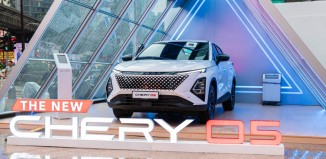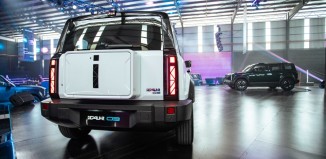New Porsche 718 Boxster Now Available
Kuala Lumpur, 02 August, 2016 – The Porsche 718 Boxster, officially launched today by Sime Darby Auto performance (SDAP), the official importer of Porsche in Malaysia, is set to be a really popular model for aspiring Porsche buyers – and more so when they launch the Cayman version.
For the uninitiated, the Boxster is the convertible version with an electrically retractable roof, while the Cayman is the hard top version. Both the new 718 Boxster and soon-to-come Cayman share the same platform and mechanicals.
What is more attractive is that the new 718 series will have down-sized engines, which makes them practical in terms of road tax in the first place, and another piece of good news is that despite the down-sizing, the new power trains are supplemented with turbo-charging, making them more powerful than their predecessors.
 Two decades after the first Boxster made its debut, Porsche is restructuring its mid-engine roadsters. The new models are named 718 Boxster and 718 Boxster S, paying tribute to the 718 race car, the iconic legend that was born in 1953 and took the 1960s by storm by claiming over 1,000 racing victories across the globe from Sebring to Targa Florio to Le Mans.
Two decades after the first Boxster made its debut, Porsche is restructuring its mid-engine roadsters. The new models are named 718 Boxster and 718 Boxster S, paying tribute to the 718 race car, the iconic legend that was born in 1953 and took the 1960s by storm by claiming over 1,000 racing victories across the globe from Sebring to Targa Florio to Le Mans.
“The new 718 Boxster models offer a significant leap in power and performance compared to the previous generation. It is a mid-engine sports car that combines the sporting spirit of the legendary 718 race car with that of the sports car of tomorrow,” said Arnt Bayer, Chief Executive Officer of SDAP at the launch.
 The centrepiece of the new model series is the newly developed four-cylinder flat engine with turbocharging. With a 2.0-litre engine, the 718 Boxster develops 300 horsepower, while the 718 Boxster S employs a turbocharger with variable turbine geometry, generating 350 horsepower from 2.5 litres of displacement. In the S-model, Porsche also uses a turbocharger with Variable Turbine Geometry (VTG). In fact, Porsche is now the only manufacturer to offer VTG technology in production cars with petrol-driven engines, both in the 911 Turbo and in the 718 Boxster S. Impressive here is the considerable power gain of 26 kW (35 hp) compared to the previous Boxster models and the greater efficiency of the new turbo engines. The new 718 Boxster models have fuel economy improvements of up to 13 per cent.
The centrepiece of the new model series is the newly developed four-cylinder flat engine with turbocharging. With a 2.0-litre engine, the 718 Boxster develops 300 horsepower, while the 718 Boxster S employs a turbocharger with variable turbine geometry, generating 350 horsepower from 2.5 litres of displacement. In the S-model, Porsche also uses a turbocharger with Variable Turbine Geometry (VTG). In fact, Porsche is now the only manufacturer to offer VTG technology in production cars with petrol-driven engines, both in the 911 Turbo and in the 718 Boxster S. Impressive here is the considerable power gain of 26 kW (35 hp) compared to the previous Boxster models and the greater efficiency of the new turbo engines. The new 718 Boxster models have fuel economy improvements of up to 13 per cent.
 The rear of the new models, meanwhile, is a strong expression of the superlative sporty performance that they are capable of. The cleanly-defined lines and two slim taillights that are connected by a solid accent trim are all designed to add width and prowess to the sleek overall silhouette of the new 718 Boxster models. A quintessential Boxster characteristic, the fabric roof, can be opened and closed in just 9 seconds up to a speed of 50 km/h. In addition, the latest generation of Porsche Communication Management (PCM) is included as standard. The navigation module is available as an option.
The rear of the new models, meanwhile, is a strong expression of the superlative sporty performance that they are capable of. The cleanly-defined lines and two slim taillights that are connected by a solid accent trim are all designed to add width and prowess to the sleek overall silhouette of the new 718 Boxster models. A quintessential Boxster characteristic, the fabric roof, can be opened and closed in just 9 seconds up to a speed of 50 km/h. In addition, the latest generation of Porsche Communication Management (PCM) is included as standard. The navigation module is available as an option. Efficient turbo power from four cylinders
Efficient turbo power from four cylinders
The launch of the new 718 Boxster generation represents the first time that Porsche is implementing sports cars with four-cylinder flat engines since the end of the 1960s. Turbocharging significantly boosts torque. The two-litre engine of the 718 Boxster has a maximum torque of 380 Newton metres (that is 100 Newton metres more), which is available from 1,950 rpm to 4,500 rpm. The 2.5-litre engine of the 718 Boxster S even attains 420 Newton metres (60 Newton metres more) over a speed range from 1,900 rpm to 4,500 rpm.
 Thus, the new 718 Boxster models sprint even faster. The 718 Boxster with PDK and the Sport Chrono Package can sprint from zero to 100 km/h in 4.7 seconds (0.8 seconds faster). The 718 Boxster S with the same equipment completes this discipline in 4.2 seconds (0.6 seconds faster). The top speed of the 718 Boxster is 275 km/h, and the 718 Boxster S has a top speed of 285 km/h.
Thus, the new 718 Boxster models sprint even faster. The 718 Boxster with PDK and the Sport Chrono Package can sprint from zero to 100 km/h in 4.7 seconds (0.8 seconds faster). The 718 Boxster S with the same equipment completes this discipline in 4.2 seconds (0.6 seconds faster). The top speed of the 718 Boxster is 275 km/h, and the 718 Boxster S has a top speed of 285 km/h.
The Porsche turbo concept is boosting driving performance while improving fuel economy. In the 718 Boxster, the four-cylinder flat engine with PDK has a NEDC fuel consumption figure of 6.9 l/100 km (1.0 l/100 km less). In the 718 Boxster S, the 2.5-litre turbo flat engine with PDK consumes just 7.3 l/100 km (0.9 l/100 km less). In Malaysia, the 718 Boxster models are equipped with seven-speed PDK as standard.
New design emphasizes a sharpened profile
The 718 model line can be recognised at first glance. The front end of the new roadster exhibits a more sculptured form. The front has a wider and more masculine appearance. The much larger cooling air intakes at the front are a distinct exterior expression of the new turbo engine concept. The front end of the 718 Boxster is rounded out by the new design of the bi-xenon headlights with Porsche Dynamic Light System (PDLS), and is integrated with the LED day-time running lights. The LED headlights with four-point daytime running lights are available as a new option.
 From the side view, identifying features of the new model line include new, independently styled wings and side sills. Larger air inlet panels with two fins emphasize the car’s dynamic look. The doors are now designed without door handle recess covers. New 19-inch wheels are standard on the 718 Boxster S. 20-inch diameter wheels are available as an option.
From the side view, identifying features of the new model line include new, independently styled wings and side sills. Larger air inlet panels with two fins emphasize the car’s dynamic look. The doors are now designed without door handle recess covers. New 19-inch wheels are standard on the 718 Boxster S. 20-inch diameter wheels are available as an option.
 The redesigned rear body of the 718 Boxster has a much wider look – especially due to the accent strip with integrated Porsche badge between the tail lights. The entirely redeveloped tail lights are distinguished by their three-dimensional LED technology and four-point brake lights.
The redesigned rear body of the 718 Boxster has a much wider look – especially due to the accent strip with integrated Porsche badge between the tail lights. The entirely redeveloped tail lights are distinguished by their three-dimensional LED technology and four-point brake lights.
 Sportier tuning of chassis for greater agility
Sportier tuning of chassis for greater agility
In its driving dynamics, the new roadster follows in the tracks of the original 718. The car’s completely retuned chassis enhances cornering performance. The electromechanical steering system is configured to be ten per cent more direct. This makes the 718 Boxster even more agile and easier to steer, both on circuit tracks and in everyday traffic.
Minus ten and minus 20: Porsche Active Suspension Management
Porsche Active Suspension Management (PASM) with a ten millimetre lower ride height comes in standard for both 718 Boxster models. For the first time, the PASM sport chassis with a 20 millimetres lower ride height is available as an option for the 718 Boxster S. The active chassis, which has also been retuned, offers an even broader spread between long-distance touring comfort and dynamic sporty stiffness.
Extensive Sport Chrono Package for dynamic driving experience
The optional Sport Chrono Package now comprises the Individual programme in addition to the three settings Normal, Sport and Sport Plus. In sports cars with PDK, the Sport Response Button has been added, which is located in the middle of the driving programme switch. Inspired by the racing car, it enables the driver to configure the responsiveness of the engine and the PDK to be very direct.
The interior has new Porsche Communication Management as standard
Awaiting the driver in the cockpit of the 718 Boxster is the familiar Porsche interior environment, now upgraded with new elements such as the instrument panel. Another central element of the new interior layout is the Porsche Communication Management (PCM) unit with mobile phone preparation, audio interfaces and the Sound Package Plus with 110 watts of audio power. The PCM can be extended with optional modules to thoroughly adapt it to personal requirements. For instance, a navigation module with voice control is available, which makes it easy to input driving destinations. In addition, the Connect Plus module is available as an extension of the navigation module; it provides extended online services.
The retail base price for the 718 Boxster and 718 Boxster S starts from RM 480,000.00 and RM 620,000.00. All prices stated come with a four-year warranty and free maintenance package. The price stated includes all applicable duties excluding registration fee, road tax and insurance.
718 Boxster: combined fuel consumption 7.4 – 6.9 l/100 km, urban 9.9 – 9.0 l/100 km, extra-urban 6.0 – 5.7 l/100 km; CO2 emissions 168 – 158 g/km; efficiency class (Germany): E-D.
718 Boxster S: combined fuel consumption 8.1 – 7.3 l/100 km, urban 10.7 – 9.5 l/100 km, extra-urban 6.5 – 6.0 l/100 km; CO2 emissions 184 – 167 g/km; efficiency class (Germany): F-E.


























